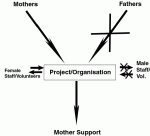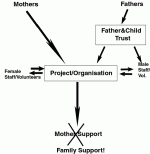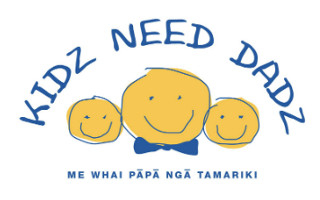Bringing Men Back Into Children’s Communities
By Harald Breiding-Buss
Annual Children’s Issues Conference “Children and their Environments”
Dunedin 28-30 June 2001
The lack of male role models in children’s lives, especially in early childhood settings, is an increasingly recognised problem in New Zealand society.
At the same time, however, men’s daytime availability has improved due to changes in the structure of work, and the social climate also demands significant involvement by fathers in the lives of their children.
Two main types of barriers prevent men from getting more involved with children of their communities other than their own. Firstly, the institutions that play an instrumental role in giving parents opportunities to interact with children are not very well set up to accommodate men.
Secondly, men themselves often lack the confidence and often competence required to make themselves more available.
The Father&Child model bridges the confidence gap between men’s time availability and their involvement in institutions dealing with young children, such as kindergartens, the Plunket Society etc. It is using its own mechanisms to improve men’s confidence and competence, for example through playgroups, and then makes those men available to provide a male face to the services of interested institutions.
The Role Model Problem
Over the last three to four generations, men have become increasingly physically removed from children’s’ environments as self-employment and employment in small nearby companies has steadily given way to the development of bigger corporates and increasing travel demands on their employees (Burgess, 1997).
Men’s removal from their immediate communities had also resulted in more and more women having homemaking as their sole occupation.
For women, this trend began to reverse in the late seventies, and women’s out-of-home employment continues to rise as a proportion of overall employment; however women’s move into the workforce was facilitated by an increasing emphasis on childcare, where supervision by mothers is replaced by supervision by another one or more females.
For men, changes in the structure of work have translated into changes in the time they have available for their children (Callister, 1999).
While overall working hours for employed fathers of preschoolers continue to increase, they have become more flexible. In addition there is a substantial number of such fathers without employment.
As a result, many working age men now have more time for their young children during their children’s waking hours, and this is increasingly evident in public places such as parks or swimming pools. But men are rare in places which would enable them to get involved with children other than their own, such as Kindergartens, Playcentres, Plunket Rooms etc.
But while children in the year 2000 have overall better access to and a better relationship with their fathers than children in the year, for example, 1980, their access to a variety of male role models is still severely limited.
Table 1: Typical role models of a preschooler by gender according to amount of time spent with them. Fictional role models in italics.
| Amount of Contact | Female | Male |
|---|---|---|
| Several Times a Day | Mother | |
| Daily | Father | |
| Several times a week | EC teachers Friends of mother Female relations Friends TV characters Story characters |
Friends TV characters Story characters |
| Weekly/Several Times a Month | Other relations/friends Professionals: (midwives, Plunket nurses, PAFT workers, GYM teachers, coaches etc.) |
Friends of father Male relations Coaches Tradesmen |
At the same time, however, fictional male role models have become more accessible.
The accessibility of media of all types – books, TV, video games, computer games, internet – is still increasing, and a child may now spend more time with fictional than real male characters. Fictional male characters can be described as action-oriented and are usually involved in a good vs. evil struggle.
While positive fictional males are usually shown as protective, they tend to be lacking in a focus on interpersonal relationships and an active role in looking after another person.
Most children have emotionally significant relationships with several adult females – their mothers, preschool teachers, female relatives, friends of the mother. However most children have only one emotionally significant relationship with an adult male – their father.
Young children live in a world that is overwhelmingly female, and the male contribution to this world is not obvious to a child.
As dad disappears from home for a large number of hours each week into a working world that is increasingly hard to explain to a young child, TV and other media offer the only reasonably cohesive picture about what men in our Society are all about – chasing villains (or being the villains themselves), being action people, being fighters.
In this world, the caring and involved part of a father may appear to the child as unusual in a male, as it is not reaffirmed by other males. A father’s role model is easily overwhelmed by fictional role models, which are more numerous and more accessible, but incomplete at best.
And in many cases, not even fathers are available to their children on a regular basis due to separation.
This is very much reflected in a boy’s play: while mothers’ role around the house is reflected very early in a girl’s play, the fathers role around the house, his work, or his other involvements in the community are much less frequently re-enacted by their boys.
While girls have their mother’s role model about at least one of women’s important roles in our Society reinforced by several other real-life sources, boys do not see their fathers’ contribution reflected in other adult males.
In fact, fathers often themselves believe that their way of caring for their children is unusual and not representative.
Real-life males that children can observe usually come in the form of tradesmen or other manual labourers: builders, carpenters, plumbers, gardeners, rubbish collectors. In the eyes of a young child the difference between the genders is very distinct: women are the carers, men are the workers.
If it is mum that does the painting at home, and dad who does most of the caring, this can teach a child that such things are possible, even acceptable, but not that they are normal. To establish a normality around men’s caring or nurturing roles, children would need more role models than their own fathers.
They need the men in their communities to be more available to them.
The Service Provision Problem
The same flexibility in the workforce that has made fathers more available for their children also makes them potentially more available to get involved with other children in the community.
Yet, while there is some largely anecdotal evidence that more men are using Playcentres (see, for example, Scanlan, 2001), male involvement in kindergartens, primary schools, playgroups and other organised childhood activities remains rare.
New Zealand and Australian research (Mitchell et al., 2000; Russell, 1999) has found that such settings are often not perceived by fathers as helpful.
However, fathers who spend more daytime with their children than the mother felt slightly better looked after by health service providers such as Plunket nurses or midwives than their ‘traditional’ counterparts.
In such families it is often the working mothers who complain about the inaccessibility of parenting information and activities to them (Breiding-Buss, 1999b). This underlines a regrettable focus of our parent and child health service system on the ‘primary caregiver’ model in childraising, which I had pointed out in an earlier paper (Breiding-Buss, 1999a).
Although used by almost all such services, this model is in conflict with an expressed desire by New Zealanders overall to share parenting tasks equally between fathers and mothers.
A study by the Office of the Children’s Commissioner (Julian, 2000) had found over 90% support among a randomly selected sample of 2000 New Zealanders for, for example, mothers and fathers sharing equally in helping the children with behavioural problems, problems at school, or discipline.
This approach, however, is not supported in the practice of service provision.
There are various barriers to men for joining institutions especially in early childhood settings, most notably a culture that is perceived as very female in those organisations and (consequently) a lack of male faces fathers could relate to, but also their appearance and self-promotion, the language of their publications, and staff attitudes (Breiding-Buss, 1999).
In focus groups, both men and women have also expressed media images, men’s upbringing, and the Family Court as major barriers for the role of fathers. (Julian, 1999; Mitchell et al., 2000).
And while more workplace flexibility has meant more time for children for many fathers, workplace attitudes and structure remain a significant barrier (Julian, 2000; EEO, 1998).
Men with dependent children work on average more hours than men without (Callister 1998, Moss/Brannen, 1990), and while those hours are in many cases more flexible, they come with pressures that may impact on the quality of their relationship with their children.
Fears of being accused of inappropriate sexual behaviour have also prevented men from chosing early childhood or primary school age childrens-related professional careers (Julian, 1999); in the Father&Child Trust’s work this is an especially strong issue with middle-aged and older males, probably due to high profile anti incest campaigns in the eighties.
However, in workshops and groups that I facilitate especially with expecting or young fathers, this has become a markedly less important issue, which is being less frequently discussed.
The Confidence Problem
Perhaps the most outstanding obstacle for men to become more involved with the children of their communities are their own (and Society’s) confidence in their child handling skills as well as how they see their role in parenting in relation to the mother.
The OCC survey already mentioned (Julian, 2000) also found that while there is large support for ideas of shared parenting within New Zealand Society, respondents were markedly more critical about men’s ability to meet such expectations.
45% of respondents agreed with the statement “Women are better at looking after children”, 47% disagreed.
Among men, 53% agreed – women are more confident in men’s parenting skills than men.
I have called this the “confidence gap” in a previous paper (Breiding-Buss, 2000a) as it reflects both Society’s as well as men’s own gap between expectations on men’s role in child raising on the one hand, and confidence in men’s capabilities on the other.
The Nelson study (Mitchell et al, 2000) pointed to another interesting phenomenon: When asked about their perceptions about health and parenting services the researchers observed that the respondents initially they answered for their wives and children.
The interviewers had to make some effort to explain to the men that this survey is about their own perceptions.
The men did not perceive themselves as valid recipients of child health or parenting services. The researchers also noted that, contrary to common belief about men being unable to ‘open up’, participants were eager and willing to share their opinions, beliefs and perceptions with the researchers, once that initial hurdle had been taken.
Other overseas studies have found similar attitudes. US research found that while men competently handled their small children when by themselves, they handed over caregiving management to their partners when they were present. They were then following their partners’ instructions. (Fitzgerald, 2001)
While men enjoy parenting and time with children, they appear to rank this as secondary to their role as support persons for their partners.
In men’s groups I facilitate for antenatal classes, the men usually express their expectation of the birth of their child as a landmark event in their lives; however, they see their attendance there as a duty to their partners rather than as a father welcoming his child into the world (Breiding-Buss, 2000b).
Men do not assert themselves as parents because they seem to perceive such assertiveness as compromising their supporting role for their partners.
Moreover, there is a difference between handling one’s own children and handling someone else’s.
Comforting your own child which had hurt himself is not the same as comforting someone else’s. Managing your own child’s misbehaviour is not the same as having to manage someone else’s which is playing at your house.
Women usually gain enough experience in babysitting other people’s children through networks they establish in playgroups and other mother-focussed activities to be able to handle such challenges confidently.
Men do not have many such opportunities, which impacts negatively on their confidence.
The Father&Child Model
The Father & Child Trust recognises the importance some institutions have in building parents’ networks and parenting skills, both of which positively impacts on parents’ confidence.
Those institutions working in the early childhood sector have an especially important role to play; with the arrival of the first baby, men’s and women’s relationships to friends and their own families change dramatically.
Over the first two or three years, women especially develop an entirely new network of friends, usually other mothers with young children, and midwives, Plunket nurses and other similar professionals are instrumental in assisting with this process (Breiding-Buss, 2000).
Those professionals have, for the same reason, a key role to play in the father’s networking and adjustment to the new situation. And yet, they often fail.
Men report of midwives visits that “she treated me as though I was not there”; eye contact with the father is often avoided by either midwives of Plunket nurses, aggravated by the father’s own possible problems with his confidence, as discussed above; Plunket nurses phoning a house ask for the mother if a man answers the phone.
All these are examples of subtle messages that exclude the father from parenting networks, for which these professionals hold the key, and further undermine his confidence.
There seems to be a high level of awareness, however, amongst professionals about their failure to deliver to fathers, and about the importance of getting them involved. But there is a lack of knowledge about how to do so.
Partly, this knowledge does not exist in the academic area or is not easily accessible: both research and practice in the field of Early Childhood Development are dominated by women, and research about barriers to fathers involvement has often not made it into the mainstream publications.
Documentation about successful practical concepts of father involvement is especially rare. The academic sector at present cannot provide the answers for the question ‘how’, only for the ‘why’.
To the other part, institutions at present are unable to create this knowledge by themselves such as by involving men in the delivery of their services. Involving men would lead to relevant feedback and, if properly addressed, improved policy and practice which would result in more inclusive service delivery.
However, as involving men in the first place, even a very small number, has proven to be a major stumbling block, this process cannot be set in motion.
The Father&Child Trust is offering itself as an interim provider of father input in this situation – something I describe as a ‘Rent-a-Dad’ approach.
The Trust has the means, although on a small scale at present, to ‘train’ fathers as competent and confident parents through playgroups and essentially the same mechanisms that make mothers competent and confident: efficient and effective networking with relevant people, including their peers.
These fathers are then available as parent helpers, or to participate in other programmes such as Plunket’s “Tots and Toddlers” scheme, where demand for males competent in baby- or childcare is particularly high. (Fig. 2a + b).
 Fig 2 a: Without involvement of fathers it is difficult to recruit male staff/volunteers, and vice versa. The project or service is solely a mother support service, even if intended to be inclusive.
Fig 2 a: Without involvement of fathers it is difficult to recruit male staff/volunteers, and vice versa. The project or service is solely a mother support service, even if intended to be inclusive.
 Fig 2 b: The Father&Child Trust as a stepping stone to involving fathers and recruiting male staff/volunteers to mainstream services.
Fig 2 b: The Father&Child Trust as a stepping stone to involving fathers and recruiting male staff/volunteers to mainstream services.
This approach is at work at present in a project with the Christchurch Plunket Society, called Postnatal Adjustment Programme (PNAP). Involvement of fathers in the programme became possible after a male facilitator could be contracted from the Father&Child Trust.
Feedback from the fathers involved in the programme has led to various changes, such as the time when their involvement starts and increased consideration for the father’s perspective of and impact on relationship issues contributing to the woman’s depression.
Finally, the Trust’s involvement has been increased to provide home support to fathers with symptoms of depression themselves, or with partners who are suffering from particularly severe depression.
A paper on the Father&Child Trust’s involvement in PNAP is forthcoming; it is an example of how the Trust can act as an interim to assist the involvement of males in a female-dominated environment and programme, where appropriate, and how this involvement can lead to changes in the programme, which make it more inclusive.
Conclusions
Our childrens’ needs for a variety of both male and female role models, as well as our Society’s expectations for male and female role sharing are two major reasons for getting men more involved in the communities of their children.
Pre-school settings such as kindergartens, playcentres or the playgroups offered by various providers are the most easily accessible services where such involvement could happen, but both structural issues within such services as well as confidence issues for the men need to be addressed.
Both local and central governments can play an important role in funding community-based practical initiatives, facilitating the education of the parent and health service +sector on these issues, and initiating policy reviews for its own departments and the organisations for which it is the principal funder.
Models for such government involvement exist, for example, in the UK, US and Australia.
Internationally, father involvement in general, and male involvement in early childhood in particular is increasingly recognised as a significant social issue.
The Hague-based Bernard-van-Leer Foundation, for example, a major sponsor of early childhood development projects in 40 countries around the world, has recently adopted fatherhood as one of three main strands in its funding strategy for the next four years (BvL Press Release; Monasso, 2001).
At the same time, the Father&Child community approach compared very favourably with initiatives overseas in terms of its effectiveness and innovativeness at a recent International Fatherhood Conference in Atlanta, US (NPCL, 2001).
The PNAP programme in Christchurch is an example of a unique collaboration between a well established service provider (the Plunket Society) and a community-based fathers organisation (Father&Child Trust), which could serve as an effective model for many other organisations.
References:
Bernard van Leer Foundation (2001): Press Release “Fatherhood”, 23 June 2001.
Breiding-Buss, H. (1999a): “Developing Support Services For Fathers” Social Policy Forum, Wellington, April 1999: in: Perspectives on Fathering II, Centre of Public Policy Evaluation, Massey University,
/cppe-papers/cppeip06/ch4.pdf
Breiding-Buss, H. (1999b):”Non-Stereotypical Fathers”, in: Perspectives on Fathering, Centre of Public Policy Evaluation, Massey University; /cppe-papers/cppeip04/cppeip4f.pdf
Breiding-Buss, H. (2000a):”Supporting a Team Approach in Parenting: A New Vision For Parent Support.” Social Policy Forum on Children’s Rights, Wellington, October 2000.
fatherandchild.org.nz/papers/supporting-a-team-approach-in-parenting-a-new-vision-for-parent-support/
Breiding-Buss, H. (2000b):”Involving Men in Maternity Services”, Public Health Conference, Palmerston North, July 2000. In: Inclusion or Exclusion: Family Strategy and Policy, Centre for Public Policy Evaluation, Massey University; The Research Case for Involving Young Men in Young Parents Services
Burgess, A. (1997): “Fatherhood Reclaimed”, Random House, London
Callister, P. (1998) “Work-rich” and “work-poor” individuals and families: Changes in the distribution of paid work from 1986 to 1996, Social Policy Journal of New Zealand, 10: 101-121
Callister,P. (1999):”No Job, No Wife? – Fathers, Paid Work and Changes in Living Arrangements in New Zealand” In: Perspectives on Fathering II , Centre of Public Policy Evaluation, Massey University;
/cppe-papers/cppeip06/ch12.pdf
EEO Trust (1998):”It’s True, Men Have Families, Too”; Work&Family files, reproduced in: Father&Child #3 pp. 8; Father&Child Trust Christchurch;
Fitzgerald, H.E. (2001):”Fathers And Toddlers: Lessons Being Learned From Early Head Start”. Presentation to International Fatherhood Conference, Atlanta, May 2001 (publication forthcoming).
Julian, R. (1999): “Focus on Fathers”, Office of the Children’s Commissioner, Wellington;
/cppe-papers/cppeip06/ch2.pdf
Julian, R. (2000): “Fathering in the New Millenium”, Office of the Children’s Commissioner, Wellington
Mitchell, D., MacIntosh, C., Chapman, P. (2000): “Real Dads – Real Men: A study of Father’s Experiences of Child and Family Services”; Nelson Marlborough Health Services;
fatherandchild.org.nz/fatherhood-foundation/fathers-experiences-of-child-and-family-services-summary.htm
Monasso, W. (2001): “The Changing Roles of Fathers” In: Early Childhood Matters # 97 pp.7, Bernard-van-Leer Foundation, The Hague.
Moss,P.; Brannen, J. (1990): “Fathers and Employment”. In: Lewis, Ch, O’Brien, M.: Reassessing Fatherhood, Sage Publications, London.
NPCL (2001): “Affirmations of Fatherhood”, 3rd Annual International Fatherhood Conference, Atlanta, Georgia, USA. internationalfathers.org
Russell, G. (1999): “Fitting Fathers Into Families: Men and the fatherhood role in contemporary Australia”. Dept. of Family and Community Services (Aust.).
Scanlan,T. (2001):“Keep Away From The Slime“, in: Father&Child #15 pp.6; Father&Child Trust Christchurch




